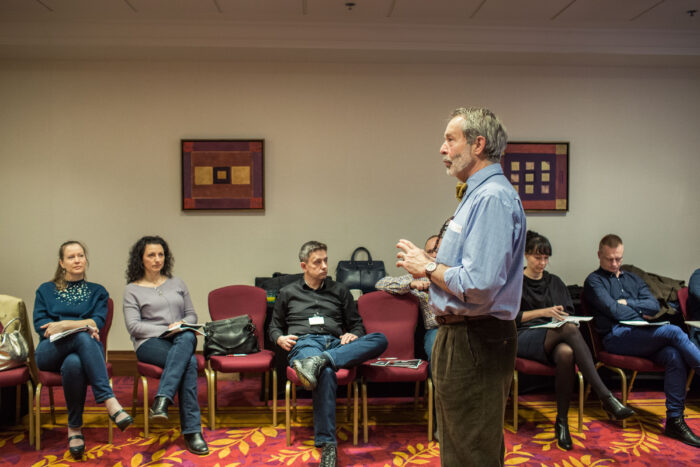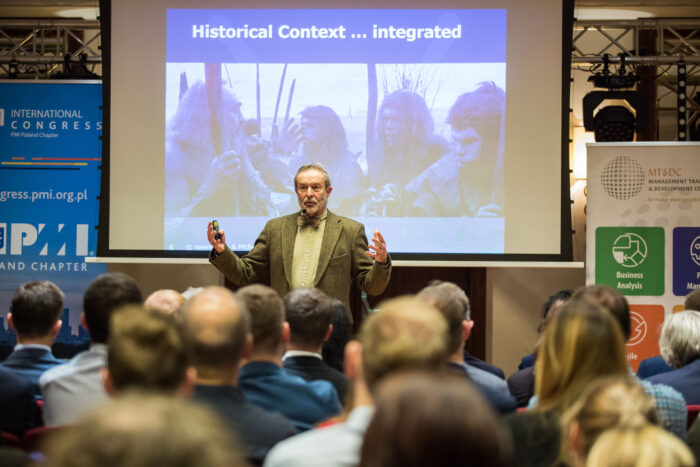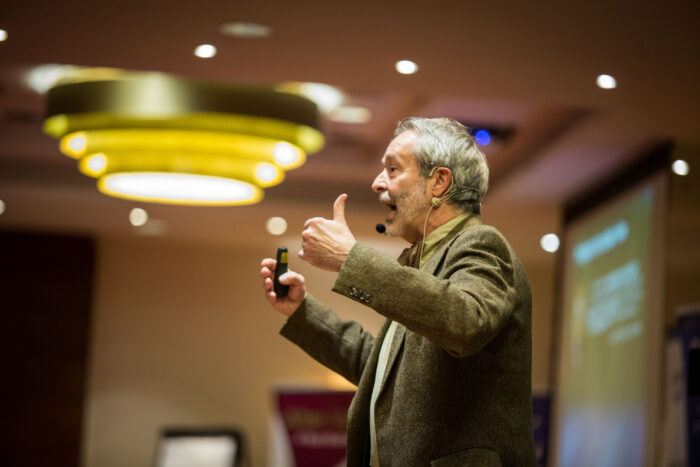An interview with Michel Thiry, conducted by Andrzej Kacperski
Michel, could you tell me which project management approach do you prefer when you are driving projects? Are you rather a Waterfall of Agile enthusiast?
I prefer a blend. It is more as I say in English “horses for courses”, it depends on the circumstances. If you have well-defined objectives, you do not think they will change and you think that you can predict the outcome, then probably Waterfall is the best solution, or traditional project management as we say. If there is a possibility that things may change because you are working in a turbulent and complex environment, also maybe because requirements have not been well-defined at the beginning, then it is preferable to work in a more Agile way where you can adjust as you go. But again, in the Agile approach, when you have a sprint, each sprint is fairly well defined. In program management each cycle of the program should also be well-defined, but the program as a whole is a series of cycles where you cannot really predict the end, like in Agile you cannot predict the end of the project – you can only predict the next sprint. So that is where I think I would see the mix and the harmonization.
How exactly should the hybrid work? Where should be some point of time in which we should change the approach? Should we use the agile for planning and then switch to waterfall for execution?
It is not about changing, it is about combining. You do not switch from one to another, you combine both. For anything that requires a decision process, for example when you see opportunities, there is a change and you have to make decisions, you use more of an Agile technique. You are constantly in contact with your customers, you constantly review the objectives. Where the decision has been made and you know very clearly what are you going to provide, then I would use the Waterfall but it can change during the project so it is not necessarily used in planning as some suggest. If you have a clear project charter your planning should be done in a waterfall approach where you do the WBS, risk management, estimates and all that, because you have the right data, you have enough data or you can have a very clear path if you want. If your path is unclear, if you do not know exactly what decision you are going to make, then you would use an Agile approach whether it is in execution or in planning – doesn’t matter.
 Fot. Konrad Zalewski
Fot. Konrad ZalewskiI can imagine how to use one or the other approach in different stages or situations in the project. But how can we really make a hybrid, a mix of both methodologies, to use it simultaneously at the same time?
That’s where I talk more about program management for the bigger picture, the higher level and use an Agile approach for the program. When you have to make decisions, define the strategy, define the objectives, identify the needs and expectations of your customers and all that. When that is done then you would use the Waterfall approach to deliver products and results. When the results are delivered, in order to achieve the benefits, you put that in operations and that again becomes a kind of Agile project because you must get feedback, you have to measure, you have to see how it works and then maybe adapt. It is like the prototyping approach where you create the prototype, you see how that prototype works, is the customer happy with it and then, based on that, you make a decision for the next cycle and then it is again Waterfall. That’s a series of cycles of Agile, Waterfall, Agile, Waterfall, Agile, Waterfall… The Waterfall is good at managing uncertainty, the uncertainty is higher at the begging and lower at the end of the project so basically it goes down as a project advances. Whereas the ambiguity goes up and down all the time. Every time you make a decision you have ambiguity. Then you make the decision and the ambiguity drops. When you have a new decision to make, because things have evolved, your client wants a change or because you have a new competitor on the market that comes up with the similar product, you have to make a decision again. As you have a decision to make the ambiguity goes up. Every time the ambiguity goes up you would use Agile more. When the ambiguity goes down and you have a clear path you would use a Waterfall so in fact it will be a mix of both all the time depending on what circumstances you are in.
Do you think that organizations and project managers are able to choose when to use the correct approach? Can they be really aware which approach should be used in the specific moment?
They can learn. At the beginning it is not easy because oftentimes, when I start using these concepts, a lot of people confuse the uncertainty and ambiguity as well as they confuse complex and complicated. Uncertainty is when you do not have enough data, you have to make a lot of assumptions and you do not have enough proven or hard data. That is uncertainty. Ambiguity is when you have multiple choices, it is generally triggered by complexity and complexity is usually created by relationships, by the way things work together. For example, a plate of spaghetti is complex, because you put spaghetti and oil and you take a fork, you turn it, you bring it up and you never know what you are going to have. But it is simple because you only have spaghetti and oil. Typically I use flights of birds as an example of complexity. Birds flying is very simple. The instruction is for example that I cannot be closer than 10 cm from another bird and I cannot be further than 20 cm. So, every time a bird on the outside of the flock sees a raptor, the second bird does not see it, but they move and as they move all the birds move in conjunction. So you are never going to predict how it is going to move but it is very simple. Complicated is when you have many pieces and the pieces always assemble the same way like a Lego or a car. It is assembled from many pieces, but if you have a plan you can always do that. Complexity is related with the fact you have multiple choices you can make decisions that will lead you in a different way. Uncertainty is when you have one direction, but you don’t have all the information you need to know exactly how you are going to get there. For example, ambiguity is when you are exploring and you are walking with a compass that shows the north. You know which direction you need to go but you will adapt and adjust as you go. The uncertainty in the Waterfall method is when you have a map that shows you exactly where you have to go, but you may have things that have happened and were not planned. You don’t have all the data. So that is the difference, I think.
 Fot. Konrad Zalewski
Fot. Konrad ZalewskiThese days the hybrids get more and more popular in the motor industry. Do you think it will come to the project management as well?
I think “hybrid” is a new buzzword. We had many buzzwords, “Agile” was a buzzword too. Agile concepts existed for many years and actually we did Agile before it has been created or named. So I think that it is a new buzzword, so it will help consultants to sell services but we have always done hybrid anyway. The problem lies more with the fact that before we tried to separate project from operations. The project is something isolated. I think that we are coming back to something that was before the project management has been identified as a specific thing and that is something that I think we should do. So hybrid is more about integration or harmonization of methods. Hybrid is in fact a bit a wrong word because hybrid just says you take 2 things that are different, you blend it together and you get something that is better. Whereas I think that it should have always been integrated. It is not about taking one thing and the other and trying to make them work together in sequence. It is really about harmonization and integration.
I have a feeling that the hybrid car is a great example of what you are talking about. Actually maybe better that we can see at the first time. There is an electric engine that works in a certain conditions and when the conditions change the gas engine starts to play together with the electric one. They are working separately or together depending on the circumstances and external conditions. Should it work the same with choosing the methods depending on the project environment.
Yes and if you take a look at the example of car it is a very good example because in the past the car was a motor, a wheel to drive and a 4 wheels. Today you have so much electronic in the car that many people cannot fix their car any more. You have electric windows, you have beepers for the seatbelts, you have camera at the front, camera at the back, another beeper when you are driving back, sensors all around the car that tells you that your lights are out or the temperature is low and the road may be frozen. So it is not a hybrid just in terms of the fuel it uses but it is also hybrid in the way that the car is build. Today the cars are almost like the computers and probably they have the same computer capability as the one we have sent to the moon years ago. At the back of the driver seats you can have a television so that your kids feel like in a living room and you keep them happy in the same time when you are a driver and you can monitor for example how the power is being distributed on the wheels. So it is more than just 2 things, it is a number of things and I think that that is what we are missing. With a hybrid we are still focusing on the project management and I think these days we should look more at the integrated organizational project management where project management, program management, portfolios, strategy and operations are all harmonized and integrated within the organization. Looking only from just a part of Agile vs Waterfall, is in my opinion reducing it. Lean, value management, TQM and at the same time business as usual, how we blend it with business as usual, how we do the transition to the business after the project is finished, how we understand the strategy. A lot of the problems I see in the organizations is when people design the strategy at the high level, people do projects at the low level and there is no link. The projects are not linked to the strategy, how do we link this to the strategy? Those really bring the whole thing together, not just within the project we do Agile or Waterfall, that is just a really small issue of a bigger picture.
 Fot. Konrad Zalewski
Fot. Konrad Zalewski
Michel is recognized worldwide in applications of project, program, portfolio and value management at the organizational level. He supported the development of portfolio frameworks and strategic programs for major corporations in various fields using agile and change concepts. He has extensive worldwide experience and has worked in many cultural environments. Dr. Thiry is a regular keynote speaker for major international events, both at the academic and practice levels, since 1996. In 2013, PMI published a revised and updated version of his book, A Framework for Value Management Practice. The first edition of his book, Program Management, received an Award of Merit by the Canadian Project Management Association and is on PMI’s recommended list of readings for the Program Management Professional (PgMP)® exam. The second edition came out in 2017. He was also a significant contributor to The Standard for Program Management – Third Edition (2013), and was on the core team of Managing Change in Organizations: A Practice Guide (2013).

[ENG] Portfolio Management Expert with a long-term experience in global organizations running the projects on 4 continents. A subject matter expert in Portfolio Governance Model Design and Implementation, which enables the organization to focus the resources and talents on development towards the organization vision. Uses his knowledge and experience to continuously increase the organization efficiency. He supports the organization from the Bottom to the Top in jointly achieving the company’s strategic goals.
[PL] Ekspert Portfolio Management z wieloletnim stażem w globalnych organizacjach realizujących projekty na 4 kontynentach. Mimo że dołączył do Allegro z początkiem tego roku świetnie odnajduje się w portfelu polskiego giganta e-commerce. Wnosi świeże spojrzenie i nie boi się zadawać trudnych pytań. Dzięki swojej wiedzy i doświadczeniu sukcesywnie pracuje nad zwiększeniem efektywności organizacji poprzez realizację inicjatyw zorientowanych na wsparcie jej celów strategicznych. Pomimo wcześniejszych doświadczeń w dużo większych organizacjach widać, że jest w nim startupowy duch Allegro!